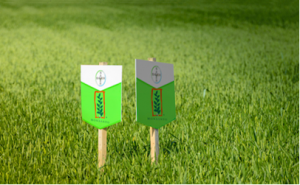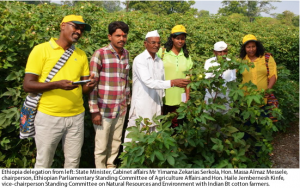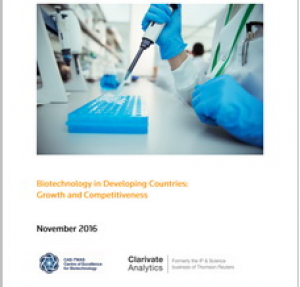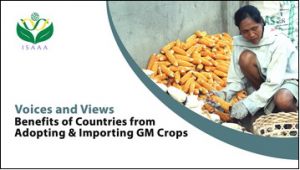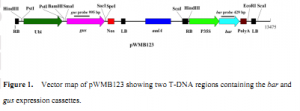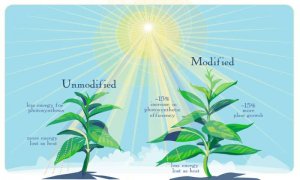Researchers from the Natural History Museum of Denmark published a study of a 5,310-year-old maize cob from the Tehuacan Valley of Mexico, providing new insights into the early stages of maize domestication. In the gene-by-gene analysis, the ancient sample shows many key genes had already been modified through human selection, including the lack of a hard seed coat and changes in flowering time.
The U.S. Court of Appeals released their 30-page ruling that counties cannot regulate pesticides or genetically engineered crops. This is following the partial ban on planting GE crops in Hawaii Country, which is now invalid after the ruling. The appellate court said that the ban violated state and federal law. They also found that the pesticide laws of Hawaii are comprehensive enough for safeguard, and that the Legislature intended it to be "uniform and exclusive of additional, local rules."
An international team of scientists successfully boosted the productivity of plants by altering mechanisms involved in photosynthesis. The result of their proof-of-concept study is published in the journal Science. The scientists targeted three genes in tobacco plants which are involved in sunshield. These genes are responsible in protecting the plant from bright sunlight by converting photons into harmless heat
A high-level delegation consisting of parliamentarians, government executives, scientists, cotton sub-sector players and the media from Ethiopia, Kenya, Malawi, Swaziland, and Zambia visited Bt cotton fields in Maharashtra State of India on November 15, 2016. Indian cotton farmers led by farmer Shivaji Bhagal of Aurangabad district showcased the extra-long staple Bt cotton to Ethiopian State Minister of Cabinet Affairs
A new report released by Beijing-based CAS-TWAS Centre of Excellence for Biotechnology says that the developing world is achieving significant growth in a broad cross-section of biotechnology fields, many of them directly tied to food production, health, and other dimensions of human well-being.
ISAAA releases a new video in the Voices and Views series titled Benefits of Countries from Adopting and Importing GM Crops. The video presents the viewpoints of biotech experts and stakeholders from different adopting countries such as Burkina Faso, Brazil, South Africa, and China.
In a study on two groups of parasites, the team detected differences in DNA sequences that could be attributed to the composition of their food. The results are published in the journal Genome Biology. Study co-author Dr Steven Kelly, from Oxford's Department of Plant Sciences, said: 'Organisms construct their DNA using building blocks they get from food. Our hypothesis was that the composition of this food could alter an organism's DNA.
Scientists from the Chinese Academy of Agricultural Sciences reported the first successful generation of marker-free transgenic hexaploid wheat using commercial Chinese wheat varieties. Transgenic wheat plants were generated using Agrobacterium-mediated transformation, and were confirmed using Quickstix strips, histochemical staining
Researchers who have sequenced the genome of a 5,310-year-old corn cob have discovered that the maize grown in central Mexico all those years ago was genetically more similar to modern maize than to its wild ancestor. For example, the ancient maize already carried genetic variants responsible for making kernels soft, a common feature of modern corn. The findings are reported in Current Biology on November 17.
"Around 9,000 years ago in modern-day Mexico, people started collecting and consuming teosinte, a wild grass," says Nathan Wales of the Natural History Museum of Denmark.
Read more at: http://phys.org/news/2016-11-genome-sequence-year-old-maize-cob.html#jCp
"Archaeological specimens frequently have high levels of bacterial DNA due to decomposition and soil contaminants," he says. "However, during genetic testing of ancient cobs, we were astonished to find that 70 percent of the DNA from the Tehuacan162 cob was from the plant!" Most other ancient samples contain less than 10 percent plant DNA. Tehuacan162 didn't have hard seed coats like its wild ancestor would have. But, the ancient cob is less than a tenth of the size of modern cobs, at less than two centimeters long. In addition, the ancient cob produced only eight rows of kernels, about half that of modern maize.
Researchers report in the journal Science that they can increase plant productivity by boosting levels of three proteins involved in photosynthesis. In field trials, the scientists saw increases of 14 percent to 20 percent in the productivity of their modified tobacco plants. The work confirms that photosynthesis can be made more efficient to increase plant yield, a hypothesis some in the scientific community once doubted was possible.


 Curently online :
Curently online :
 Total visitors :
Total visitors :

